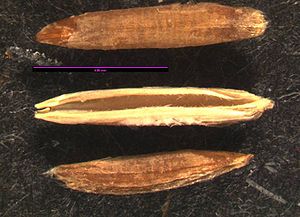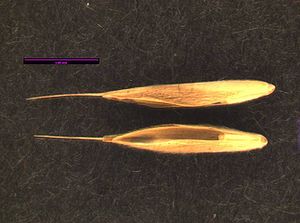Difference between revisions of "Bromus sitchensis var. carinatus"
| Line 25: | Line 25: | ||
==References== | ==References== | ||
[[File:Bromus caritanus.jpg|thumb|right|300px|''Bromus carinatus'']] | [[File:Bromus caritanus.jpg|thumb|right|300px|''Bromus carinatus'']] | ||
| + | [[File:Bromus caritanus 2.jpg|thumb|right|300px|''Bromus carinatus'']] | ||
| + | |||
Revision as of 12:21, 28 April 2012
Contents
Taxonomy
Description
Perennial It is hardy to zone 0. The flowers are hermaphrodite (have both male and female organs) and are pollinated by Flies, bees, beetles. The plant is self-fertile. The plant prefers light (sandy), medium (loamy) and heavy (clay) soils and requires well-drained soil. The plant prefers acid, neutral and basic (alkaline) soils. It can grow in semi-shade (light woodland) or no shade. It requires moist soil.
Bloom Period
Distribution
N. America. N.E. Asia.
Habitat
Bog Garden; Cultivated Beds; Banks of streams, in swamps or on wet rocks, Labrador to Alaska and south to California[43].
Uses
Edible Parts: Leaves. Young leaves - raw or cooked[177]. The rosettes of the dark green shiny leaves are eaten raw or cooked[257]. A hot, cress-like flavor.
Propagation
We have very little information on this species and do not know if it will be hardy in Britain, though judging by its native range it should succeed outdoors in most parts of this country. The following notes are based on the general needs of the genus. Succeeds in sun or shade in a moist well-drained soil[200].
Seed - sow in situ in early spring to early summer.
Photo Gallery
References
Seed
Abbreviation: BRCA
Seed sample from: 2008
Average measurement: 14.6 x 1.5 x 1.5
Measurement range: L: 13.5 – 16 W: 1.1 – 1.8 D: 1.2 - 2
Features
Shape: Inner seed is about ½ the size of its husk, and brown.
Color:Seed husk tan, tending to be whiter toward hilium, and browner towards awn.
Surface:Hilium is somewhat glossy, while rest of husk is very hairy. Awn is brown and straight. Surface of seed longitudinally striate and glossy.



